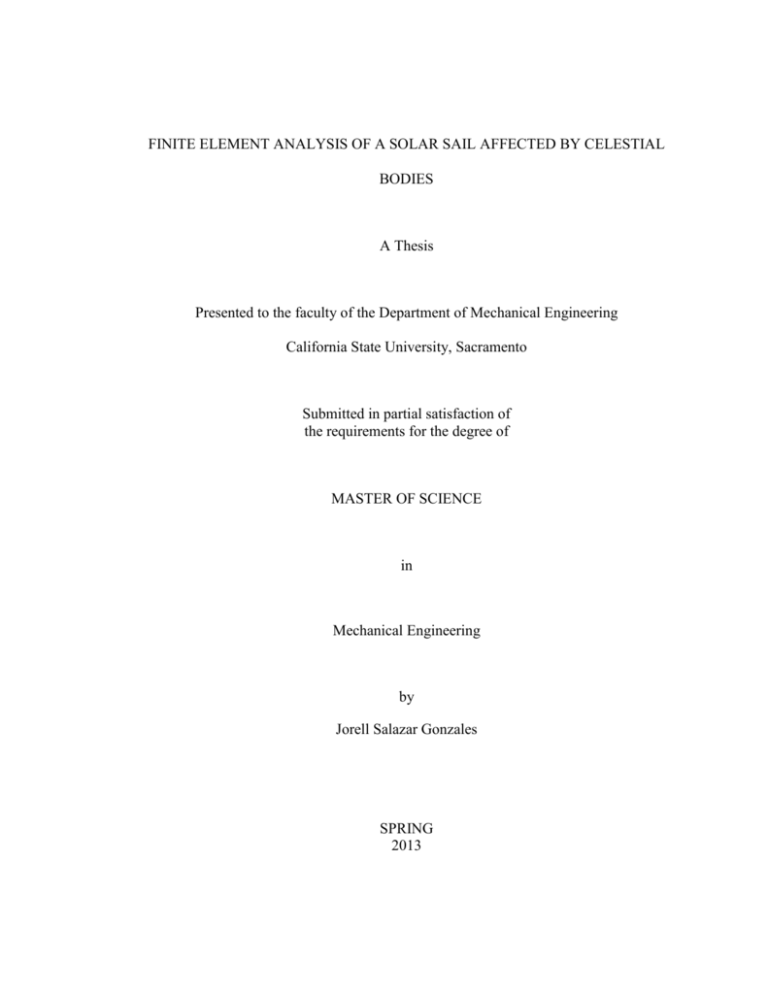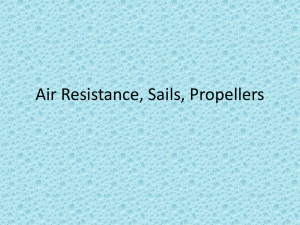
FINITE ELEMENT ANALYSIS OF A SOLAR SAIL AFFECTED BY CELESTIAL
BODIES
A Thesis
Presented to the faculty of the Department of Mechanical Engineering
California State University, Sacramento
Submitted in partial satisfaction of
the requirements for the degree of
MASTER OF SCIENCE
in
Mechanical Engineering
by
Jorell Salazar Gonzales
SPRING
2013
© 2013
Jorell Salazar Gonzales
ALL RIGHTS RESERVED
ii
FINITE ELEMENT ANALYSIS OF A SOLAR SAIL AFFECTED BY CELESTIAL
BODIES
A Thesis
by
Jorell Salazar Gonzales
Approved by:
______________________________________, Committee Chair
Illhan Tuzcu, Ph.D
______________________________________, Second Reader
Akihiko Kumagai, Ph.D
_______________________________
Date
iii
Student: Jorell Salazar Gonzales
I certify that this student has met the requirements for format contained in the University
format manual, and that this thesis is suitable for shelving in the Library and credit is to
be awarded for the thesis.
__________________________, Graduate Coordinator
Akihiko Kumagai, Ph.D
Department of Mechanical Engineering
iv
___________________
Date
Abstract
of
FINITE ELEMENT ANALYSIS OF A SOLAR SAIL AFFECTED BY CELESTIAL
BODIES
by
Jorell Salazar Gonzales
Solar Sails are spacecrafts that use light propulsion to push their large sails to
accelerate forward. Just like how sailboats use the wind to move across the ocean, solar
sails use the pressure from light particles emitted from the Sun to push them forward. In
space, absent of friction, this tiny pressure provides a constant acceleration to the sails
and ultimately gain large values of velocity. Solar sails rely heavily on their massively
thin sails to remain flat. Unfortunately, these sails are prone to deformations due to
external forces encountered in space. If deformations occur, the sail will not receive the
maximum amount of solar pressure. Changes in the shape of the sail can also cause the
spacecraft to change trajectories. This paper will show the deformation of the sail due to
celestial bodies. Solidworks will be used to model and analyze these forces using the
finite element method. An analytic approach will be used to find the vibration mode
shapes and frequencies for the sail. The vibration mode shapes and frequencies will then
be compared with the values obtained from Solidworks to validate the use of the finite
v
element method. Once verified, several loads such as solar pressure and gravitational
forces from celestial bodies will be applied to the sail. Another test will be conducted to
see the amount of deformation caused by changes in sail size. This thesis is focused
completely on the analysis of the sails therefore, a simple quad-triangular solar sail
configuration is used. The results show that gravitational forces caused by celestial
bodies causes deformation to the sails depending on the orientation of the spacecraft.
Increasing the sail size causes the deformations to grow exponentially.
_______________________, Committee Chair
Ilhan Tuzcu, Ph.D
_______________________
Date
vi
ACKNOWLEDGMENTS
I would like to take the time to express my fullest gratitude to all of those who
have supported me. First I would like to thank my advisor, Dr. Ilhan Tuzcu, for his
guidance. He has shown great patience and support into the completion of this thesis.
Without his time, effort, and knowledge I would not have completed this paper. I would
also like to thank my second advisor, Dr. Akihiko Kumagai, for taking the time to go
through and revising my work.
Lastly, I would like to thank my entire family and friends, but most of all my
parents, for their countless encouragement and support. They have helped me through my
academic achievements and I dedicate my work to them.
vii
TABLE OF CONTENTS
Page
Acknowledgments……………………………………………………………………….vii
List of Tables……………………………………………………………………………...x
List of Figures…………………………………………………………………………….xi
Chapter
1. INTRODUCTION TO SOLAR SAILS..........................................................................1
1.1. Solar Sails................................................................................................................1
1.2. Previous Works on Solar Sailing.............................................................................2
1.3. Finite Element Method............................................................................................3
2. VIBRATION MODES...................................................................................................5
2.1. Newtonian Formulation...........................................................................................5
2.2. Solidworks.......................................................................................................…....7
3. SOLAR SAIL DEFORMATION................................................................................13
3.1. Solar Sail Construction..........................................................................................13
3.2. Solar Pressure........................................................................................................15
3.3. Celestial Bodies.....................................................................................................19
viii
3.4. Sail Sizing..............................................................................................................22
4. CONCLUSION.............................................................................................................24
Appendix...........................................................................................................................26
A.1. Mathematica Code for Vibration Modes..............................................................26
Bibliography......................................................................................................................27
ix
LIST OF TABLES
Tables
Page
1.
Table 2.1: Material Properties of Kapton................................................................8
2.
Table 2.2: Five Mode Frequencies Between Newtonian Approach and FEM......10
3.
Table 3.1: Material Properties................................................................................13
4.
Table 3.2: Applied Forces on Solar Sail................................................................19
x
LIST OF FIGURES
Figures
Page
1.
Figure 2.1: Infinitesimal Element of a Membrane...................................................5
2.
Figure 2.2: Right Isosceles Triangle........................................................................8
3.
Figure 2.3: Mesh Convergence................................................................................9
4.
Figure 2.4: Five Mode Shapes Using Newtonian Approach.................................11
5.
Figure 2.5: Five Mode Shapes Using FEM...........................................................12
6.
Figure 3.1: Core, Isometric View and Cross Sectional View Respectivly...…….14
7.
Figure 3.2: Boom, Left: Isometric View and Right: Cross Sectional View..........15
8.
Figure 3.3: 10 m Solar Sail Viewed in the x-y Plane. ………..…....................….15
10.
Figure 3.4: Direction of Sun Light and Surface Normal of Sail............................17
11.
Figure 3.5: Solar Sail with Applied Solar Pressure...............................................17
12.
Figure 3.6: Deformed Solar Sail Due to Applied Solar Pressure.…...…………..18
13.
Figure 3.7: Solar Sail Exposed to Gravitational Force and Solar Pressure ..........20
14.
Figure 3.8: Deformed Solar Sail Due to Gravity and Solar Pressure....................21
15.
Figure 3.9: Displacement Vs Distance..................................................................22
xi
16.
Figure 3.10: Displacement Vs. Sail Size...............................................................23
xii
1
Chapter 1
INTRODUCTION TO SOLAR SAILS
1.1 Solar Sails
Solar sails are spacecrafts that use light weight reflective sails that converts the
Suns energy into momentum. The light emitted from the Sun applies a pressure, giving a
constant force throughout the sail. The force applied to the sails of the spacecraft is
proportional to its size. Newton's second law of motion dictates that a constant force
applied to any mass will experience a constant acceleration. This would mean that the
solar sails velocity would continue to increase due to the absence of drag in space.
Without the limiting factor of fuel, solar sails are the ideal candidate for long term
missions into space. The sails acceleration is dependent on the effective area that reflects
light therefore, it is important that the sail remain a flat surface.
Though ideal, solar sails have their limitations. If the sail is truly reflective, the
amount of pressure it will experience is about 9.1x10-6 N/m2 at 1 AU [1]. Thus, in order
for the solar sail to accelerate at .1 mm/s2 it would need to have a mass to area ratio of 91
g/m2. This amount of acceleration is small when applied for space exploration therefore,
the sails are made to be very large relative to the weight of the cargo it brings. The sails
must also be ultra thin compared to its area to reduce as much weight as possible.
Unfortunately, this makes them extremely delicate. Due to this fact, sails are easily
influenced by external forces that may exist in space. Deformations or wrinkling can
result in severe consequences. Wrinkles increase intrinsic roughness which will reduce
2
their ability to reflect light. Light that is not reflected is absorbed, which will create
hotspots throughout the sail. Deformations also result in the reduction of surface area.
The spacecraft will not utilize its full acceleration and might even change trajectories
depending of the shape of deformation.
1.2 Previous Work on Solar Sailing
Studying the behavior of a solar sail has proven to be difficult on Earth. Due to
gravity, the size and weight of the sail causes it to collapse on itself. It was also found
that air friction disturbs the true behavior of a sail when ground tested. Fortunately, there
are methods of minimizing Earths effects. In [2], L' Garde Inc. studied a 10-meter solar
sail in a vacuum chamber to neglect the effects of Earth. Applied loads was added to the
sails to simulate the affects of solar pressure. The design and fabrication of this 10-meter
solar sail was studied as a small scale of their 1000 m2 solar sail they plan to launch in the
future. In [3], Sleight and Muheim presents a simulation of the behavior of a square solar
sail using the software ABAQUS. Their study was focused on the behavior of the boom
and sails under solar pressure.
There has also been several tests done on solar sail in space. The first successful
solar sail to be deployed in space was Ikaros. JAXA, a space program in Japan, deployed
Ikaros on January, 2010 and set it on a course to Venus. It is a 200 m2 sail made of 7.5
μm thick polyimide [1]. NASA also deployed their first successful solar sail, called
NanoSail D, which unfurled on January 17, 2011. The sail has an area of 10 m2 and
3
weighs 8.8lbs [1]. Both of these missions main objectives were to test the deployment of
the sails, check attitude controls, and measure acceleration.
These studies have provided a clear understanding of the solar sails behavior.
However, there has been little research done on the behavior of the sail affected by
gravitational forces from celestial bodies. These forces should be accounted for to
prevent any deformations from occurring.
There are many sail configurations that have been tested. The difference between
the performances of these configurations will not be discussed. The purpose of this paper
is only to provide the understanding of the behavior of the sail while interacting with
celestial bodies. Therefore, a simple quad-triangular solar sail configuration was chosen
to be analyzed. This paper will show the behavior of a 100 m2 sail and its interactions
with celestial bodies. To simplify things, only one celestial body will be tested which will
be Earth. This planet was selected because its properties, such as its mass, are well
known.
1.3 Finite Element Method
The methodology that will be used to analyze the solar sail will be the Finite
Element Method (FEM). FEM is the process that provides solutions to structures that
have complex geometries or are made of several composites. The approach of this
method involves taking a complex equation in a large domain and reducing it to simple
equations in a sub domain. These are called finite elements, which are all connected to
complete the entire domain once solved [4]. The accuracy of the solution is dependent on
4
the number of elements. As more elements are generated, the solution starts to converge
on the true answer . This is ideal for analyzing solar sails which are made of many
components such as the booms and sails.
Solidworks is a computer program that uses FEM to model several structures and
can be fitted with different restraints and applied with several loads. One of its many uses
is to provide a visual representation of a structure and show the stresses and deformations
at different points. This will be used to give a clear understanding of how the sails react
to external forces.
Before testing can be done on the entire spacecraft, the sail must be modeled
correctly in Solidworks. To verify this, the vibration modes will be found using FEM and
compared to the theoretical vibration modes using the Newtonian approach. Due to the
spacecrafts symmetry, testing a single triangular sail will be sufficient during the
vibration tests.
5
Chapter 2
VIBRATION MODES
2.1 Newtonian Formulation
The sail can be analyzed as a membrane, being that it has a large area with a
relatively small thickness. A membrane has no resistance to compression or bending and
behaves similarly to a string in two dimensions. In order for it to act like a structure, the
membrane must be pre-tensioned as shown in Figure 2.1 [5].
Figure 2.1 Infinitesimal Element of a Membrane
Several assumptions are made before analyzing the structure [5]. First, gravity is
considered negligible. Second, all displacements are perpendicular to the x-y plane. The
displacement is represented as the field variable w, which is a function of x, y, and time t.
The last assumption is that the thickness h and the density ρ of the material remains
6
constant throughout the membrane. Tension T, force per unit length, is also constant
along the sides. Using Newton's second law on Figure 2.1 produces
𝑑𝑤
(𝜌ℎ𝛥𝑥𝛥𝑦)𝑤𝑡𝑡 = 𝑇𝛥𝑦 (
𝑑𝑥
(𝑥+𝛥𝑥,𝑦)
−
𝑑𝑤
𝑑𝑤
𝑑𝑥 (𝑥,𝑦)
) + 𝑇𝛥𝑥 ( 𝑑𝑦
𝑑𝑤
(𝑥,𝑦+𝛥𝑦)
− 𝑑𝑦
). (2.1)
(𝑥,𝑦)
Combining like terms and solving for zero yields
𝜌ℎ𝑤𝑡𝑡 − 𝑇(𝑤𝑥𝑥 + 𝑤𝑦𝑦 ) = 0.
(2.2)
The particular solution for the differential equation is
𝑤(𝑥, 𝑦, 𝑡) = 𝑊(𝑥, 𝑦)eiωt ,
(2.3)
where W(x, y) is the eigenfunction and ω is the circular frequency. Substituting Equation
(2.3) into (2.22) will get
ω2
∇𝑊 + 𝐶 2 𝑊 = 0 ,
(2.4)
where
𝑇
𝐶 = √𝜌ℎ .
(2.5)
The variable C is the speed of the transverse waves in the membrane. The symbol ∇ is the
Laplacian operator also known as the gradient. Applying the boundary condition that
there are no displacements on its sides and the geometry of the membrane is such that x ϵ
[0, a] and y ϵ [0, b], the field variable and the circular frequency for any shape membrane
can be found. Since mode shapes are found when t=0, the eigenfunction can be used to
7
express the vibration shape of the membrane. The frequency of the membrane can be
found by dividing the circular frequency by 2π. For a right isosceles triangular
membrane, the eigenfunction and the frequency is
𝑚𝜋𝑥
𝑊(𝑥, 𝑦) = 𝑠𝑖 𝑛 (
𝑎
𝑛𝜋𝑦
) 𝑠𝑖 𝑛 (
𝑎
) − 𝑠𝑖𝑛(
𝑛𝜋𝑥
𝑎
)𝑠𝑖𝑛(
𝑚𝜋𝑦
𝑎
) where m, n = 1, 2,....,∞ (2.6)
and
𝐶
𝑓 = 2𝑎 √𝑚2 + 𝑛2 where m, n = 1, 2,....,∞
(2.7)
respectively [6]. The variable a is the side length of the triangle. The variables m and n
determine the mode the membrane is vibrating. The only modes of interest are those with
a non-zero eigenfunction. Therefore any combination of m and n that would result in a
zero solution are ignored. The program, Mathematica, was used to solve for Equations
(2.6) and (2.7).
𝑚=𝑛
𝑊(𝑥, 𝑦) = 0 { 𝑚, 𝑛 = 0.
(2.8)
2.2 Solidworks
Using Solidworks, a right isosceles triangle was made with length sides of 7.07 m
and a thickness of 2.5 μm. The material for the model sail is kapton. The properties of the
material are shown in Table 2.1 obtained from [5]. The shell feature was used which
allowed the model to be analyzed as a two dimensional problem and reduced the
necessary amount of elements. During the frequency study, fixed edges were applied to
8
the sides of the triangle to prevent movement. A tension of 1000 N was set to the sides of
the triangle. The vector sum of tension in the x and y components resulted in 1414.21 N
and was applied to side C. The applied force and direction are shown on Figure 2.2. Note
that the tension on Solidworks is not force per unit length and must be taken into account
when using Equation (2.5).
Kapton Material Properties
Elastic Modulus (N/m2) 2500000000
Poisson's Ration
0.34
3
Mass Density (kg/m )
1420
Table 2.1 Material Properties of Kapton
Figure 2.2 Right Isosceles Triangle
9
Solidworks failed to analyze the model using FFEPlus while forces were applied
to the triangle. Therefore, the solver was changed to Direct Sparse and soft springs were
used to stabilize the model. The frequency study produced the modes shapes and the
corresponding frequencies. The first few modes presented by Solidworks showed a zero
displacement in the z direction. This is consistent with Equation (2.6) where the
combination of m and n resulted in zero eigenvalues. Thus, the first true mode has a
frequency of 35.5 Hz. A mesh convergence test was used to check the accuracy of the
results. This involved increasing the element numbers until the values of frequency
showed little change. The test shows that the first mode frequency converges to 31.555
Hz shown in Figure 2.3. The amount of elements and nodes used were 4270 and 8763
respectively.
First Mode Frequency (Hz)
Mesh Convergence
31.560
31.550
31.540
31.530
31.520
31.510
31.500
31.490
420
1187 1411 1975 2157 2543 2938 3625 4270
Number of Elements
Figure 2.3 Mesh Convergence
10
Table 2.2 shows the frequencies for the first five modes of vibration for both the
Newtonian approach and FEM. Both methods produced the same shapes for the
corresponding modes of vibration as shown in Figure 2.4 and 2.5. The percent error
between the two methods was less than 1%. The error will become negligible as the
amount of elements increases. Increasing the amount of elements, however, also
increases the amount of time for the computer to analyze the problem. Fortunately, the
results are accurate enough to continue with FEM on the complete solar sail.
1000 N Applied to an Isosceles Triangle Sail
Newtonian
Solidworks (FEM)
Percent Error %
Mode (m, n) Frequency (Hz)
Frequency (Hz)
1
2,1
31.5604
31.555
0.017110049
2
3,1
44.6331
44.621
0.027109925
3
2,3
50.8896
50.873
0.032619632
4
4,1
58.1944
58.169
0.043646811
5
2,4
63.1207
63.09
0.048636976
Table 2.2 Five Mode Frequencies Between Newtonian Approach and FEM
11
Mode 1
Mode 2
Mode 3
Mode 4
Mode 5
Figure 2.4 Five Mode Shapes Using Newtonian Approach
12
Mode 1
Mode 2
Mode 3
Mode 4
Mode Shape 5
Figure 2.5 Five Mode Shapes Using FEM
13
Chapter 3
SOLAR SAIL DEFORMATION
3.1 Solar Sail Construction
The rest of the spacecraft was constructed in Solidworks for the sole purpose of
applying the proper restraints to the sails. The analysis of this paper is focused only on
the sail component, therefore the other components will be simplified to block shapes on
Solidworks. They will, however, have the proper material properties. The components of
the spacecraft include four right isosceles triangular sails, four booms, and the cargo. The
same sail from Figure 2.2 will be used. There are patches along side A for the cables to
be inserted. The cargo is the core of the spacecraft which is made out of a special
composite. It is located at the center and connects the entire spacecraft together. It is
modeled to weigh 58.85 kg which includes all scientific research that is brought during
space explorations [8]. The booms are the main support for the sail made of the same
composite as the core. The sail and the booms are connected together by a Kevlar cable.
The material properties of the necessary components are listed on Table 3.1 [8].
Material Properties
Composite Kevlar
2
Modulus (N/m ) 124x109 62x109
Poisson's Ratio
0.3
0.36
3
Density (kg/m )
1908
1440
Table 3.1 Material Properties
14
The core has a circular cross section with a diameter of 0.9 m. It is extruded by
0.5 m. A thin wall of 0.05 m was applied in order to simulate the correct weight. The
center of mass is located in the center of the circle.
Figure 3.1 Core, Isometric View and Cross Sectional View Respectively
The boom is constructed as a square cross section. The sides of the cross section
has a length of 0.25 m with a wall thickness of 0.05 m. It is extruded by 7.35 m. Three
holes are applied through the sides of the boom for cables to be inserted. Each hole has a
diameter of 1mm and are seperated by a distance of 2.12 m. The componants was
combined as shown on Figure 3.3.
15
Figure 3.2 Boom, Left: Isometric View and Right: Cross Sectional View
Figure 3.3 10 m Solar Sail Viewed in the x-y Plane
3.2 Solar Pressure
Solar Pressure is the light particles that are constantly emitted by the Sun. Any
object that interacts with the particles experiences a pressure caused by its change of
16
momentum. Maximum pressure is exerted when the momentum is perfectly reflected.
Using Planck's relationship and Newton's second law yields
𝑃=
2𝑊(cos 𝛼)2
𝑐
,
(3.1)
where c and P is the speed of light and pressure respectively. Speed of light is measured
to be 3x108 m/s. Equation (3.1) is only applied for sails that are perfectly reflective. For
the purpose of this paper, the sail being analyzed will be assumed to be perfect. The
variable W is the Suns power that reaches Earth, which is 1368 W/m2. The variable α is
the angle between the Suns direction and the surface normal of the solar sail shown in
Figure 3.4. As the distance from the Sun increases the intensity of the light diminishes.
The pressure provided decreases with the lost of intensity. The inverse square law can be
used to find the amount of pressure for any given distance. It states that the pressure is
inversely proportional to the square of the distance light has traveled [7]. Applying the
inverse square law to Equation (3.2) yields
𝑃=
2𝑊(cos 𝛼)2
𝑐𝑅 2
,
(3.2)
where R is expressed in Astronomical Units. The value of 1 AU is the average distance
between the Sun and the Earth, which is 150x106 km.
17
α
Figure 3.4 Direction of Sun Light and Surface Normal of Sail
For the following test, the model will only be subjected to solar pressure. The
spacecraft is tested at a distance of 1 AU from the Sun and α is zero degrees. The applied
pressure from these conditions is 9.1 μN/m2.This pressure will be applied to each of the
four sails in the z-direction. The booms and core is restrained, allowing only the sails to
move shown in Figure 3.5. The red arrow represent the direction of the solar pressure and
the green arrows are the restraints.
Direction of solar
pressure
Figure 3.5 Solar Sail with Applied Solar Pressure
18
As a result, the sails begin to billow out in the z-direction due to the applied
pressure shown on Figure 3.6. Most of the deformation occurs in the middle of each sails
where there is less support. The maximum displacement that occurs is 6.498x10-6 mm.
Minimum deformation occurs near the booms where it is well supported. Displacements
are as little as 1.708x10-6 mm. The amount of displacement is small considering the
magnitude of pressure applied to the sail.
Figure 3.6 Deformed Solar Sail Due to Applied Solar Pressure
3.3 Celestial Bodies
Every object presents a gravitational attraction to another. Newton's law of
gravitation expresses the force F between two masses at a distance r. This relationship is
expressed as
19
𝐹=
𝐺𝑚1 𝑚2
𝑟2
,
(3.3)
where G is the gravitational constant 6.67x10-11 Nm2/kg2 [9]. In the case of this paper, m1
is the mass of any celestial body and m2 is the mass of the sails. Gravitational force
cannot be eliminated by the presence of other objects. When multiple objects are near
each other, the total force are added together, following the superposition principle. As
the solar sail comes close to multiple bodies, one resultant gravitational force acts on the
sail. Therefore, analyzing the effect of one celestial body to the solar sail will suffice. The
celestial body that is used for this paper is Earth, which has a mass of 1.74x1022 kg.
The following constraints are assumed while conducting the following tests. The
sail is located at a distance of 384,400 km. This is the distance at which the Moon orbits
the Earth. Like the previous test, the sail is assumed to be perfectly reflective and α is
zero degrees. The applied restraints and solar pressure is the same as Figure 3.5. Thermal
build up on the sails is neglected. No other celestial bodies will be in contact to the solar
sail besides Earth. The normal surface of the sail will also be faced perpendicular from
the direction of Earth. In doing so, the light emitted by the planet will be neglected. Thus,
the only loads that is applied to the solar sail is the solar pressure from the Sun and the
gravitational force from Earth. The magnitude of each load are shown on Table 3.2.The
gravitational force is applied to the sails in the x-direction, as shown on Figure 3.7.
Applied Load
Force of gravity (N)
.00216
2
Solar Pressure (μN/m )
9.1
Table 3.2 Applied Forces on Solar Sail
20
Direction of
gravitational force
Figure 3.7 Solar Sail Exposed to Gravitational Force and Solar Pressure
Displacements in the z-direction are similar to Figure 3.6. The displacements
occurring in the x-direction are shown on Figure 3.8. The deformation shape on Figure
3.8 is exaggerated for the viewers convenience. The force caused by gravity is much
larger than solar pressure. Thus, the deformation in the x-direction is much larger than the
z-direction which explains the difference in magnitude. The largest displacements occurs
in the middle of each sail where it is least supported. The largest displacement was found
to be 2.5x10-5 mm.
21
Figure 3.8 Deformed Solar Sail Due to Gravity and Solar Pressure
Based on Equation (3.3), the force increases as it gets closer to the Earth. The
magnitude of the displacement can be expected to increase as the force increases. For the
following test the distance between the spacecraft and Earth is decreased. Figure 3.9
shows the largest displacement occurring in the solar sail as its distance to the Earth
decreases. The graph follows close to a polynomial trend line.
22
Displacement Vs. Distance
Largest Displacement (μm)
3
2.5
2
1.5
1
0.5
0
Distance from Earth (m)
Figure 3.9 Displacement Vs Distance
3.4 Sail Sizing
The size of the sail depends on the mission objective. In reality, the sail presented
on this paper is in not practical. The area of the sail is much too small to gain any real
acceleration for space exploration. Therefore, it is important to see how much
deformation occurs as the sail increases. During this sizing tests, only a triangular sail
will be tested. Since the solar sail is symmetrical, the other sails should behave in a
similar fashion. The load applied is only solar pressure and is directed the same as before.
The constraints from the previous tests and the restraints will remain the same. Side C of
the sail will be increased from 10 to 50m with increments of 10m.
23
Largest Displacement (μm)
Displacement Vs. Sail Size
1.4
1.2
1
0.8
0.6
0.4
0.2
0
10
20
30
Size (m)
40
50
Figure 3.10 Displacement Vs. Sail Size
From Figure 3.9, the largest displacement that occurs on the sail increases
exponentially as the sail increase. Following this trend shows that larger sails are more
prone to deform from external forces in space. It can be expected that larger solar sails
will have larger deformations when gravitational force is applied.
24
Chapter 4
CONCLUSION
Solar sails are spacecrafts that require only solar pressure to accelerate through
space. The sails are structures that act like a membrane. Due to this fact, they are very
delicate and prone to deformation. In this paper, gravitational forces were applied to the
sails to analyze the amount of deformation that may occur.
A vibration modes for a singular sail were found using the FEM and the
Newtonian approach. The percent error in the structural frequencies between the two
were as little as .01%. The mesh convergence test was used to increase the accuracy of
the results obtained from the FEM.
In Solidworks, the entire spacecraft was constructed for the purpose of restraining
the sail properly. Applying solar pressure to the sail caused it to billow out where it was
least supported. Maximum displacements that occured during this test was 1.708x10-6
mm. Gravitational force was then applied to the sail. The deformation mostly occurred in
the x-direction. Again, the least supported portion of the sail deformed the most. The
maximum displacements found in this test was 2.5x10-5 mm. As the distance between the
sail and the celestial body decreased, the displacements also increased. The relation
between the two showed a polynomial trend line. It can be expected that the deformation
will also increase as the solar sail approaches celestial bodies with higher values of mass.
The last test proved that increasing the sail size increased the amount of deformation. An
exponential relationship was found between the two.
25
The results show that celestial bodies caused the solar sail to deform depending
on the direction of the gravitational force. Although, the values obtained are small, these
slight changes may cause problems for deep space exploration. The intended speed for
the spacecraft may be reduced, depending on the length in time it stays deformed.
Trajectories may also be affected. These effects also exponentially increase as the size of
the sails increases. This issue should be taken into consideration while constructing a
solar sail.
26
Appendix
A.1. Mathematica Code of Vibration Modes
27
BIBLIOGRAPHY
[1] Vulpetti, Giovanni. Solar Sails. New York: Copernicus Books, pp. 73-80
[2] Lichodziejewski, David and Derbes, Billy. Development and Ground Testing of a
Compactly Stowed Scalable Inflatably Deployed Solar Sail. 2004. Feb. 2013 <
http://www.lgarde.com/assets/content/files/publications/2004-1507.pdf>
[3] Sleight, David W. and Muheim, Danneilla M. Parametric Studies of a Square Solar
Sails Using Finite Element Analysis. . Mar. 2013
<http://archive.org/stream/nasa_techdoc_20040074322/20040074322#page/n0/mode/1up
>.
[4] Lui, Gui-Rong. Mesh Free Methods: Moving Beyond the Finite Element Method.
Boca Raton: CRC Press, 2003.
[5] Hagedorn, Peter. Vibrations and Waves in Continuous Mechanical Systems. John
Wiley and Sons Ltd, pp. 179-180, 2007
[6] Wiesstein, Eric W. Wave Equation--Triangle. 8 April. 2013. 13 April. 2013
<http://mathworld.wolfram.com/waveequationtriangle.html>.
[7] Wright, Jerome L. Space Sailing. Philadelphia: Gordon and Breach Science,
pp. 93-99, 1992
[8] Gajbhiye, S.C., Upadahyay, S.H., and Harsha, S.P. Free Vibration Analysis of Flat
Thin Membrane. August 2012. March 2013 <http://www.ijest.info/docs/ijest12-04-08015.pdf>.
[9] Walker, Jearl. Fundamentals of Physics 9th Edition. Hoboken, NJ: John Wiley And
Sons, Inc., pp. 330-347, 2011








